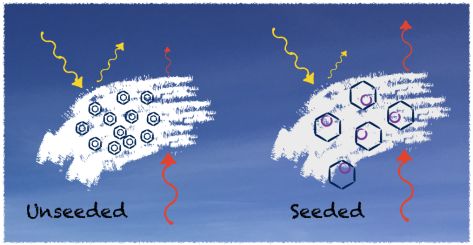
AWiCiT
Climate Engineering by Arctic Winter Cirrus Thinning: Risks and Feasibility
- Prof. Dr. Thomas Leisner // Institute of Meteorology and Climate Research - AAF - KIT Karlsruhe
- Prof. Dr. Ulrike Lohmann // Institute for Atmospheric and Climate Science - ETH Zürich
- Dr. Isabelle Steinke // Institute of Meteorology and Climate Research- TRO - KIT Karlsruhe
- Steffen Münch // Institute for Atmospheric and Climate Science - ETH Zürich
- Simon Gruber // Institute of Meteorology and Climate Research- TRO - KIT Karlsruhe
- Tobias Schorr // Institute of Meteorology and Climate Research - AAF - KIT Karlsruhe
Summary
In this project we want to investigate the climate engineering method of cirrus cloud thinning during Arctic Winter (Arctic Winter Cirrus Thinning, AWiCiT).
Cirrus clouds are thin clouds at high altitudes consisting of ice crystals. They mostly have a warming effect on climate. Cirrus clouds can form with and without the presence of ice nucleating particles (e.g. dust particles). If they form without ice nucleating particles, the ice crystals are numerous but small. However, if there are some ice nucleating particles present, the ice crystals form on these particles. This occurs earlier than freezing without particles and therefore results in fewer but larger ice crystals (as the same amount of water vapor is distributed on fewer crystals). These are optically thinner, will sediment faster, and therefore have a smaller lifetime.
The general warming effect of cirrus clouds results from a cooling by reflection of incoming solar radiation and a warming by absorption and re-emission of the outgoing terrestrial radiation. As there is no solar radiation during polar night, there cirrus clouds have only a warming effect. The climate engineering approach is to seed the arctic winter atmosphere with additional ice nucleating particles. We will investigate if this could be done along flight routes of commercial airplanes. Then, ice crystals should form on these particles instead of freezing without particles. This should reduce their optical thickness, their lifetime, and thereby their warming effect. If successful, this climate engineering method could help to reduce the Arctic temperature amplification (stronger warming of the Arctic due to the ice-albedo-feedback) and to slow down the melting of the Arctic sea ice.
To study AWiCiT we will use the AIDA chamber to investigate the freezing processes, the ICON-ART model to study the cirrus cloud seeding and the ECHAM-HAM model to investigate the global influence of AWiCiT on radiation and sea ice.
Cirrus clouds are thin clouds at high altitudes consisting of ice crystals. They mostly have a warming effect on climate. Cirrus clouds can form with and without the presence of ice nucleating particles (e.g. dust particles). If they form without ice nucleating particles, the ice crystals are numerous but small. However, if there are some ice nucleating particles present, the ice crystals form on these particles. This occurs earlier than freezing without particles and therefore results in fewer but larger ice crystals (as the same amount of water vapor is distributed on fewer crystals). These are optically thinner, will sediment faster, and therefore have a smaller lifetime.
The general warming effect of cirrus clouds results from a cooling by reflection of incoming solar radiation and a warming by absorption and re-emission of the outgoing terrestrial radiation. As there is no solar radiation during polar night, there cirrus clouds have only a warming effect. The climate engineering approach is to seed the arctic winter atmosphere with additional ice nucleating particles. We will investigate if this could be done along flight routes of commercial airplanes. Then, ice crystals should form on these particles instead of freezing without particles. This should reduce their optical thickness, their lifetime, and thereby their warming effect. If successful, this climate engineering method could help to reduce the Arctic temperature amplification (stronger warming of the Arctic due to the ice-albedo-feedback) and to slow down the melting of the Arctic sea ice.
To study AWiCiT we will use the AIDA chamber to investigate the freezing processes, the ICON-ART model to study the cirrus cloud seeding and the ECHAM-HAM model to investigate the global influence of AWiCiT on radiation and sea ice.
K E Y O B J E C T I V E S
|
||||
|
||||
|
||||
|
||||
|
||||
|
||||

Schematic of seeded and unseeded cirrus cloud properties. The yellow arrows represent solar shortwave radiation and the red arrows represent terrestrial longwave radiation. The seeded cirrus reflects less solar radiation but it also absorbs less terrestrial radiation. As the last effect dominates in average the seeded cirrus has a lower warming effect.
